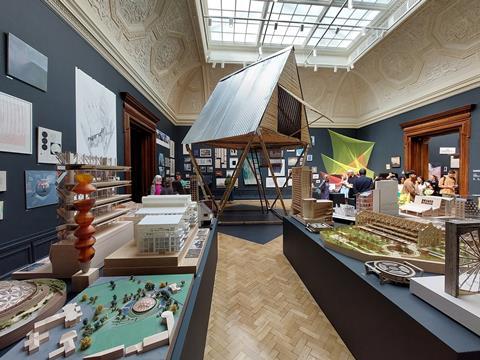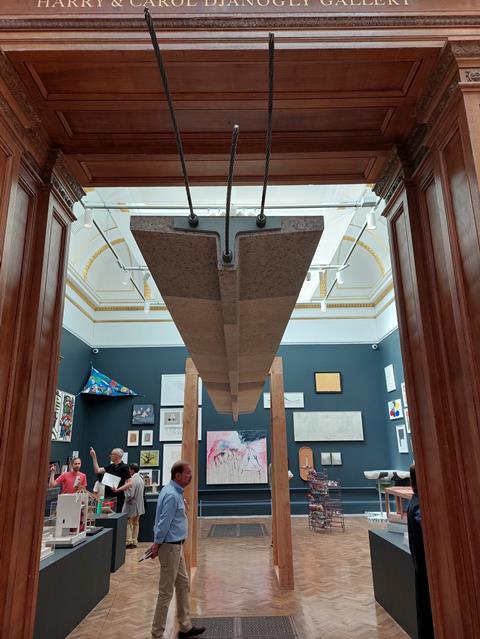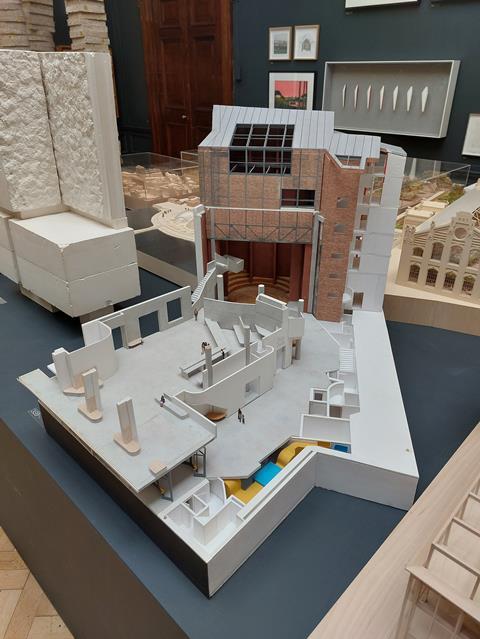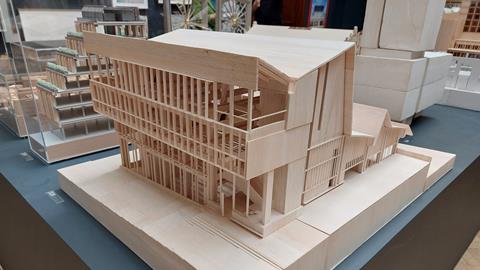The RA’s architecture room focuses on the climate emergency, but only underlines the inadequacy of most architects’ responses, writes Ben Flatman

2022 is the Royal Academy Summer Exhibition’s 253rd iteration. Past visits have left me with a sense that many academicians are simply dialling it in, with the architecture room often stuffed with slick but uninspiring presentation models and large printouts you might expect to see at a meeting with the quantity surveyor.
As I enter the courtyard of this venerable institution from Piccadilly, I find myself wondering whether the responsibility for curating the rooms is seen as a gift or a poison chalice. Decisions about who to leave in and who to leave out, and who to just push to the corner, must be a minefield.
In a seeming acknowledgement that curating the architecture room (actually two rooms this year) is a difficult and lonely challenge for one person alone, Níall McLaughlin requested that he work with his fellow academician, the artist Rana Begum.
A full-scale installation of one of Tabassum’s demountable bamboo houses dominates the second architecture room in the exhibition
As McLaughlin explains, he and Begum are among the newest academicians – “the new kids on the block”, as he puts it. And there is clearly a sense of camaraderie between them and a relief perhaps that the burden has been shared.
They bonded over a mutual admiration for Marina Tabassum, the leading Bangladeshi architect, and Aga Khan Award winner. And a full-scale installation of one of Tabassum’s demountable bamboo houses dominates the second architecture room in the exhibition.
The houses double as flood shelters, designed to meet the needs of Rohingya refugees and low-income Bangladeshis in what is a cyclone-prone delta environment. It’s a dramatic change of direction for an architect previously best known for her beautifully austere brick and concrete buildings.
“Climate” is the theme of this year’s Royal Academy Summer Exhibition, chosen by Alison Wilding, the show’s co-ordinator. It’s a deliberately amorphous heading, but McLaughlin and Begum have chosen to give their curation a clear climate emergency spin.
The result is a refreshing change to the slightly reheated ambience that tends to dominate the show
McLaughlin explains that it was a fellow academician, Grayson Perry, who had observed a prevailing sense of fatalism in the UK around climate change. McLaughlin felt that architects could offer a different perspective and asked contributors to demonstrate this with “telling examples of positive action signalling hope.”
It is apparently the first time that two academicians have co-curated the architecture room, and the result is a refreshing change to the slightly reheated ambience that tends to dominate the show.
As you would expect from McLaughlin, there is plenty of good “proper” architecture. Models and drawings of interesting projects that speak of his interest in the tangible world of solidity and natural materials. A beautiful installation, made of recycled and pre-stressed stone, designed by Webb Yates, hovers over the first room.

But these pieces are off-set and complemented by his and Begum’s mingling of artist produced painting and photography. “We really wanted some uncertainty about whether the work was by an artist or an architect,” says McLaughlin as he talks me through the show.
The approach seems to have largely paid off, although there are the inevitable odd corners where it is all too obvious that the work is mainly there because someone is too famous to be left out.
I find Begum deep in conversation with Boonserm Premthada, the Thai architect known for his advocacy of locally sourced materials. She has obviously also relished the opportunity to bounce ideas off of her collaborator. “I’ve always been interested in and influenced by architecture in my own work,” she tells me, by way of explaining the connection with McLaughlin.

The presence of Tabassum and Premthada’s work gives the selection a distinctly Asian influence. Anna Heringer has also contributed a beautiful hanging textile piece, made by Bangladeshi craftswomen, that shows the intricate network of rivers that spread like veins across the Bengal delta.

As I explore the exhibition for myself, I appreciate the eclectic mix. There is a freshness and diversity that lifts this exhibition and helps give its underlying themes a real sense of urgency and purpose.
But I also cannot help noticing the huge contrast in responses to the climate emergency. McLaughlin tells me that contributors were asked to demonstrate how the world’s environmental challenges “were impacting their theoretical and material practice”.
There are lots of interesting examples. Grafton Architects, a practice best known for carbon-intensive concrete monoliths, have shared a model of their first timber framed building, an innovation centre for the University of Arkansas.

Premthada has contributed a structure made from elephant dung bricks. Rather than ship elephant dung from Thailand, at considerable cost to the environment, staff from McLaughlin’s office collected it from zoos around London. It is a knowingly entertaining but also provocative piece – a mix of serious proposal and amuse-bouche.
Nearby is a model of White Arkitekter’s Sara Cultural Centre in Sweden. It is Europe’s tallest timber framed building and McLaughlin is keen to point out that it would be all but impossible to build in the UK today.
Like a lot of UK architects currently, he notes that regulation and problems with insurance have become significant obstacles to designing sustainably.

He also hails Flores Prats, based in Barcelona, for their “amazingly inventive work” and praises them for how they adopt the approach that “an existing building is an opportunity rather than an impediment”. Their model shows a project to rehabilitate a 1930s theatre in Brussels into a new cultural laboratory.

Stepping back and speaking more broadly about the profession, he observes that “it is never too late to change your practice, although some people have just continued to send us steel and glass skyscrapers”.
And that sense - that our profession’s response is too slow and too little - permeates the exhibition. As some peripheral voices are trying to point out, climate change is now essentially an inevitability. Marina Tabassum’s work, which is essentially a response to current crisis and impending catastrophe, is therefore perhaps the most honest piece in the room.
This year the exhibition also incorporates works to commemorate the lives of Richard Rogers and Chris Wilkinson. McLaughlin has managed to bring in an early concept model for the Pompidou Centre, on loan from Paris. “I love this,” he tells me. “It’s like taking a vinyl LP out of its cover.” It’s also a throwback to a time when steel and glass buildings were seen as contentious for completely different reasons.

McLaughlin and Begum have brought a light touch and enjoyably thought-provoking edge to what is an often rather staid architecture room. It feels that closer collaboration between the architectural and art curators is a new tradition that the RA should be keen to continue.
Postscript
The Royal Academy’s 2022 Summer Exhibtion runs from Tuesday, 21 June to Sunday, 21 August

















No comments yet